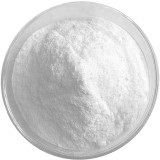 |
Calcium Lactobionate USP FCC Food Grade Supplier Exporter Manufacturers' Representative |
Email: info@ammol.org |
Call Toll Free +1-855-552-6665 |
Quick Links to Products: Calcium Borogluconate | Calcium Bromo Lactobionate | Calcium Citrate | Calcium Disodium EDTA | Calcium Lactobionate Suppliers | Calcium Pantothenate | Calcium Saccharate | Lactobionic Acid | Ramipril | Sodium Lactobionate | and more -- |
Calcium Lactobionate
CAS Number: 110638-68-1
Molecular Formula: C24H42CaO24-2H2O
Molecular Weight: 790.68

Calcium Lactobionate
Calcium Lactobionate USP Grade Specifications
C24H42CaO24.2H2O -- 790.68
D-Gluconic acid, 4-O- -D-galactopyranosyl-, calcium salt (2:1), dihydrate.
Lactobionic acid, calcium salt (2:1), dihydrate.
Calcium lactobionate (1:2), dihydrate [CAS 110638-68-1].
Calcium Lactobionate contains not less than 96.0 percent and not more than 102.0 percent of C24H42CaO24.2H2O.
Identification:
A: A solution (1 in 50) responds to the tests for Calcium.
B: Infrared Absorption 197K.
C: Dissolve a quantity of it in water to obtain a test solution containing 10 mg per mL. Similarly prepare a Standard solution of USP Calcium Lactobionate RS in water containing 10 mg per mL. Apply separately 5 :L of the test solution and 5 :L of the Standard solution to a suitable thin-layer chromatographic plate coated with a 0.25-mm layer of chromatographic silica gel. Dry the plate in a current of cool air. Place the plate in a suitable chromatographic chamber lined with filter paper and previously equilibrated with a solvent system consisting of a mixture of alcohol, water, ethyl acetate, and ammonium hydroxide (50:30:10:10). Develop the chromatogram until the solvent front has moved about three-fourths of the length of the plate. Remove the plate from the chamber, and dry at 100 for 20 minutes. Allow to cool, and spray with a spray reagent prepared as follows. Dissolve 2.5 g of ammonium molybdate in about 50 mL of 2 N sulfuric acid in a 100-mL volumetric flask, add 1.0 g of ceric sulfate, swirl to dissolve, dilute with 2 N sulfuric acid to volume, and mix. Heat the plate at 110 for about 10 minutes: the principal spot obtained from the test solution corresponds in color, size, and RF value to that obtained from the Standard solution.
Specific rotation: between +22.0 and +26.5 .
pH: between 5.4 and 7.4, in a solution (1 in 20).
Halides: A 1.2-g portion tested as directed under Chloride shows no more turbidity than corresponds to 0.7 mL of 0.020 N hydrochloric acid (0.04%).
Sulfate: A 2.0-g portion dissolved in boiling water shows no more sulfate than corresponds to 1 mL of 0.020 N sulfuric acid (0.05%).
Heavy metals: Mix 1 g with 4 mL of 1.2 N hydrochloric acid, add water to make 25 mL, warm gently until dissolved, and cool to room temperature: the limit is 0.002%.
Reducing substances: Transfer 1.0 g to a 250-mL conical flask, dissolve in 20 mL of water, and add 25 mL of alkaline cupric citrate. Cover the flask, boil gently for 5 minutes, accurately timed, and cool rapidly to room temperature. Add 25 mL of 0.6 N acetic acid, 10.0 mL of 0.1 N iodine, and 10 mL of 3 N hydrochloric acid, and titrate with 0.1 N sodium thiosulfate VS, adding 3 mL of starch as the endpoint is approached. Perform a blank determination, omitting the specimen, and note the difference in volumes required. Each mL of the difference in volume of 0.1 N sodium thiosulfate consumed is equivalent to 2.7 mg of reducing substances (as dextrose): the limit is 1.0%.
Calcium Lactobionate FCC Food Grade Specifications
Calcium 4-(_,D-Galactosido)-D-gluconate
C24H42CaO24 Formula wt, anhydrous 754.66
CAS 5001-51-4
DESCRIPTION
Calcium Lactobionate occurs as a white to cream-colored, free-flowing powder. It readily forms double salts, such as the chloride, bromide, and gluconate. It is anhydrous when obtained by spray-drying, or the dihydrate when obtained by crystallization. It is freely soluble in water, but insoluble in alcohol and in ether. It decomposes at about 120C. The pH of a 1:10 aqueous solution is between 6.5 and 7.5.
Function: Firming agent in dry pudding mixes; nutrient.
REQUIREMENTS
Labeling: Indicate whether the product has been obtained through spray-drying or from crystallization.
Identification
A. The infrared absorption spectrum of a potassium bromide dispersion of the sample, previously dried at 105C for 8 h, exhibits relative maxima at the same wavelengths as those of a similar preparation of USP Calcium Lactobionate Reference Standard.
B. A sample gives positive tests for Calcium.
Calcium Content: Not less than 5.05% and not more than 5.55% of calcium (Ca), calculated on the dried basis.
Halides: Not more than 0.04%.
Lead: Not more than 2 mg/kg.
Loss on Drying: Not more than 8.0%.
Optical (Specific) Rotation [α]D20C: Between +23° and +25°.
Reducing Substances: Not more than 1.0%.
Sulfate: Not more than 0.7%.
Please visit SDS Safety Data Sheet of Calcium Lactobionate Suppliers.
American Molecules, also known as ammol.org is a distributor, supplier and manufacturers' representative of all types of Pharmaceuticals, Functional Ingredients, Excipients and Specialty Chemicals in Texas USA. Our principals manufacture supply and export USP NF BP, Ph Eur, etc grades of chemicals pure and reagent grade, mineral fortifiers, FCC food grade. Tailor made particle size and customized specifications are offered. The principal's facility is having one or more of the certifications like FDA approval and GLP, cGMP, ISO9001, ISO14001, ISO/IEC 17025, ISO22000, FSSC 22000, ISO45001, FSSAI, Kosher, HALAL, COPP, WHO-GMP certified and Written Confirmation (WC) for export to Europe is available. The manufacturers suppliers and exporters observe WHO Good Manufacturing Practices and Good Laboratory Practices.





Suppliers and Manufacturers' Representative:

9910 Bent Oak Dr
Houston, TX 77040, USA
Call Toll Free: 1-855-55-AMMOL 1-855-552-6665
Email: info@ammol.org